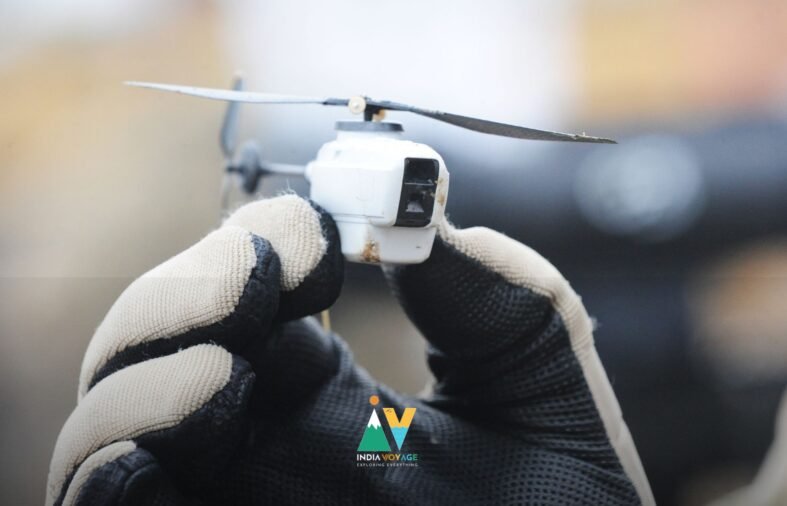By Pritesh Khare, DGCA-Certified Remote Pilot
Published on May 31, 2025, at 08:28 AM IST
The Black Hornet Nano, a cutting-edge micro unmanned aerial vehicle (UAV), is transforming tactical intelligence gathering with its tiny footprint and sophisticated technology. Originally crafted by Norway’s Prox Dynamics AS and now produced by Teledyne FLIR after its 2016 acquisition, this miniature drone equips soldiers with immediate situational awareness through advanced surveillance capabilities. This article delves into its standout features and the global militaries that have integrated it into their operations.
Distinctive Features of the Black Hornet
1. Ultra-Small and Portable Build
The Black Hornet is among the smallest military UAVs, with dimensions of about 16 × 2.5 cm (6 × 1 in) and a weight of only 18 grams for the Black Hornet 3, while the newer Black Hornet 4 weighs 70 grams. Its compact size allows it to be carried in a soldier’s pocket or clipped to a belt, enabling rapid deployment in under 20 seconds. This makes it ideal for operations in confined spaces, urban settings, or covert missions where larger drones are impractical.
2. Stealthy and Discreet Operation
With an almost inaudible flight profile, the Black Hornet can operate just 10 feet from a person without detection. Its tiny size and minimal visual signature make it nearly invisible, offering a significant advantage for stealthy reconnaissance in sensitive environments like urban battlegrounds or enemy territories.
3. High-Quality Imaging Systems
The drone is fitted with advanced electro-optical and thermal imaging cameras, delivering sharp video (640 × 480 resolution) and high-resolution stills (1,600 × 1,200 for Black Hornet 3, upgraded to 12-megapixel in Black Hornet 4). Its thermal imaging supports nighttime operations, and adjustable cameras allow soldiers to safely survey structures, enemy positions, or hazardous zones without direct exposure.
4. Impressive Range and Endurance
The Black Hornet 3 can fly for up to 25 minutes with a range of about 2 kilometers (1.24 miles). The Black Hornet 4 extends this to over 30 minutes and a range beyond 2 kilometers, even in winds up to 25 knots. These capabilities enable it to navigate diverse terrains, including GPS-denied areas, making it versatile for missions in complex environments like caves or cityscapes.
5. Smart and Intuitive Controls
The drone supports both manual operation via a handheld controller and autonomous flight through pre-set GPS waypoints. Its onboard artificial intelligence allows it to follow designated paths, adapt to changing conditions, and return to its operator independently. The Black Hornet 3 and 4 feature a modular design for quick battery and sensor changes, paired with user-friendly software for seamless mission planning.
6. Durable and Weather-Tolerant
Built with lightweight materials such as carbon fiber and robust polymers, the Black Hornet is both sturdy and aerodynamic, capable of enduring winds up to 20 knots (Black Hornet 3). Its rugged construction ensures reliability in demanding battlefield conditions, enhancing its dependability for troops.
7. Black Recon Variant
Launched in 2023, the Black Recon is a heavier variant (350 grams) designed for vehicle-mounted operations. Stored in an 80 kg launch system on armored vehicles, it houses three UAVs that can autonomously launch and recover, offering a 6 km range and 45-minute flight time. This model boosts situational awareness for vehicle crews in high-threat scenarios.
Global Military Adoption
The Black Hornet has been embraced by over 45 nations, particularly NATO members and other global forces, for its unmatched reconnaissance capabilities. Below are some key adopters:
- United States: The U.S. Army adopted the Black Hornet 3 in 2018 through the Soldier Borne Sensor program, with contracts exceeding $300 million, including a $91 million deal for Black Hornet 4 in 2023. It’s used by units like the 82nd Airborne and Special Forces, with some units donated to Ukraine.
- United Kingdom: The British Army employed 324 Black Hornets in Afghanistan’s Operation Herrick, phased them out in 2016, but reintroduced them in 2019 for brigade-level surveillance.
- Norway: As the drone’s birthplace, Norway’s military was an early adopter, using it for tactical reconnaissance.
- France: French forces utilize the Black Hornet for special operations and intelligence gathering.
- Germany: The German military has recently ordered Black Hornet 4 systems, with deliveries planned through 2027.
- Australia: The Australian Army deploys the drone for tactical surveillance, especially in special forces missions.
- India: The Indian Army uses Black Hornets for counter-terrorism operations in regions like Jammu and Kashmir.
- Ukraine: Equipped by Norway and the UK, Ukrainian forces, including the Kraken SOF regiment, rely on the drone for urban reconnaissance and targeting.
- Other Nations: Countries like Denmark, Algeria, Ireland, the Netherlands, Poland, New Zealand, Turkey, South Africa, and Morocco have also adopted the Black Hornet, with over 33,000 units delivered worldwide.
Significance and Future Prospects
The Black Hornet’s ability to deliver covert, real-time intelligence has made it indispensable for modern warfare, particularly in urban and close-combat scenarios. Despite its high cost—around $195,000 per unit—its value for elite units and special operations is unmatched. The U.S. Army’s continued investment and the Black Hornet 4’s selection for the Blue UAS Refresh program in 2025 highlight its growing importance.
Beyond military applications, the Black Hornet has potential in civilian sectors, such as search and rescue and structural inspections, as seen in its use during a New York City parking garage collapse. Future developments aim to lower costs for wider adoption, potentially equipping every squad leader with this critical tool.











Leave A Reply